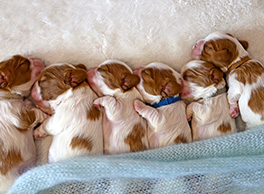
Responsible Dog Breeding: A Guide to Canine Insemination
While many dogs are in shelters, some pet parents may want a specific breed of dog, particular bloodlines, dogs for shows and competitions or to start a business. It is essential to understand how to breed dogs in a way that is safe for both the female dog and the puppies. Your vet can perform genetic testing, provide OFA (Orthopedic Foundation for Animals) certifications, test hormone levels, semen extraction, and more.
When should you breed your dog?
Female dogs should not be bred until after their second heat cycle. After consulting with your veterinarian, the ideal timeline to start breeding typically falls between seven to 14 days after the beginning of the heat cycle (estrus cycle).
Smaller dog breeds tend to experience their first heat cycle at around six months. However, larger dogs like Great Danes may have their first heat cycle at 18 months old, though this can vary depending on the individual dog and its breed. Generally, larger dogs take longer to reach maturity.
How can you tell that your dog is in heat?
Generally speaking, you can tell your dog is in heat when the following happens.
- Bleeding during estrus
- Visible enlargement of the vulva
For pet parents interested in breeding, it’s crucial to consult a veterinarian no later than the fifth day from the first appearance of blood, signifying the start of the heat cycle as the first sight of blood marks day one. By day five, veterinarians can begin monitoring the progesterone levels. It’s worth noting that the duration of a dog’s heat cycle can vary, but approximately 70% of female dogs experience a normal heat cycle.
Can dogs breed naturally?
While some dogs can naturally mate or breed, certain breeds, like Bulldogs, need assistance in reproducing. Larger breeds may encounter difficulties due to aggression or uncooperative mates. The key to success is planning and consultations with your veterinarians beforehand. Vets use tools like progesterone testing to help pinpoint the optimal breeding time and ensure proper support for our dogs.
What is progestogen testing?
Ensuring the female’s ability to sustain pregnancy is a vital aspect of responsible breeding, as is consulting your veterinarian for necessary tests. Progesterone testing plays a pivotal role in this process. Progesterone, a hormone produced by female organs, regulates uterine lining production for implantation after fertilization and supports pregnancy for 59 to 63 days.
At CyFair Animal Hospital, we conduct this internationally recognized test using an IDEX machine renowned for its precise progesterone calculations. Our breeding practices have consistently achieved success rates ranging from 80% to 90%. It is crucial to highlight that human progesterone tests are not reliable indicators for canines. Therefore, we strongly advise investing the time and resources to collaborate with a veterinarian to obtain accurate results.
Do I need a vet to breed my dog?
Our mission is to promote the well-being of animals, ensuring they have fulfilling lives alongside their companions. We recommended genetic testing to help make that possible. Genetic testing helps identify potential health issues in advance. For example, dogs with a history of hereditary heart disease shouldn’t breed, and we recommend sterilization.
Similarly, animals with conditions like joint disease, hip dysplasia, arthritis, or a predisposition to cancer should not be bred. Consulting with your veterinarian can help identify and address these concerns, ensuring the production of healthy offspring.
How does artificial insemination in canines work?
We’re taking sperm from a male dog, and we’re entering it into the female reproductive tract of the female dog. First, we take the sperm and ensure its viability under a microscope. We then use a pipette to inseminate the female via the vagina.
Alternatively, surgical artificial insemination offers a 90% accuracy rate, where we enter the abdomen, elevate the female’s reproductive tract, and directly inject the sperm into the uterus.
What different types of semen can be used for insemination?
We can collect the sperm from the male in our office, or we can use sperm that has been previously collected and is either frozen or chilled.
How long does it take to know if insemination is effective?
We perform crucial checks at specific intervals after insemination to monitor the progress of the pregnancy. Around 28 days post-insemination, we use an ultrasound to visualize viable embryos developing within the uterus.
Upon confirming successful insemination, we conduct X-rays on day 55 to determine the exact count of puppies. This stage also reveals the ossification or calcification of the puppies’ skeletons, providing valuable insights into their development. Around day 58, we initiate reverse progesterone testing to determine when to perform the Cesarean section (C-section).
What is a reverse progesterone test?
A reverse progesterone test allows us to track the rate of progesterone decline at the end of the gestation period. When it’s time to give birth, we want to see those progesterone numbers come down to three nanograms per milliliter, which tells us that the female is at or near where she should be to give birth.
How can you tell when a female dog is ready to give birth?
Behavioral signs such as increased milk production, nesting behavior, and heightened panting can signal that the dog is approaching labor. Additionally, we may observe a drop in their body temperature from the typical range of 100.5 to 102.5 degrees Fahrenheit down to 97 degrees.
In addition to monitoring the mother’s behavior, we closely monitor the puppies’ vital signs and health markers. We’re constantly tracking fetal heart rates, assessing gastrointestinal motility, and ensuring the kidney health of the developing puppies.
At Cy-Fair Animal Hospital, we know that by taking care of the dog mom, we also ensure the puppies’ health and safety. Our dedicated team is committed to providing your dog with a secure and nurturing breeding process.


